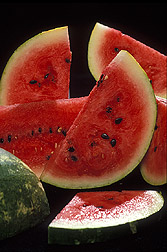This page has been archived and is being provided for reference purposes only. The page is no longer being updated, and therefore, links on the page may be invalid.
|
Bottlegourd Gene May Curb Cucurbit Virus
By Ann PerryOctober 3, 2007
Bottlegourds have been used around the world for food, bottles, bowls, spoons, musical instruments and even bird houses. Now a "genetic" genie in the versatile bottlegourd may be used to reduce virus infestation in watermelons.
Agricultural Research Service (ARS) plant pathologist Kai-Shu Ling and geneticist Amnon Levi conduct research on plant diseases at the U.S. Vegetable Laboratory in Charleston, S.C. They are looking for tools to fight zucchini yellow mosaic virus (ZYMV), which infects cucurbit crops: cucumbers, melons, pumpkins, squash, bottlegourds and watermelons.
Throughout North America, several viruses transmitted by insects, including ZYMV, are especially troublesome to watermelons and other cucurbit crops. Producers are anxious to find new ways of suppressing these viruses. Previous research by other scientists suggested that bottlegourd (Lagenaria siceraria) had some genetic resistance to ZYMV, but this research needed followup.
Ling and Levi obtained seeds for 190 bottlegourd accessions that were collected from different parts of the world and kept at the ARS Plant Genetic Resources Conservation Unit in Griffin, Ga. They raised the seeds in their Charleston greenhouses, and then inoculated the bottlegourd plants with ZYMV and evaluated how well they resisted the virus.
To their surprise, 36 accessions of the 190 screened—33 from India alone—were completely resistant to ZYMV infection, and another 64 accessions were partially resistant. They also found that ZYMV resistance is heritable in crosses between different bottlegourd accessions, enabling the development of bottlegourd varieties with enhanced virus resistance.
Popular watermelon cultivars could be grafted onto bottlegourd rootstocks with enhanced resistance to bolster the watermelons’ ability to resist ZYMV. Some watermelon growers have already been experimenting with grafting watermelon on bottlegourd rootstocks to control soilborne diseases and to enhance fruit production and quality.
Ling and Levi’s success in identifying disease-resistant bottlegourd accessions will further efforts to find environmentally friendly ways of controlling watermelon pathogens and pests. For producers of a U.S. commodity worth $435 million in 2006, that would be a wish come true.
ARS is the U.S. Department of Agriculture's chief scientific research agency.

